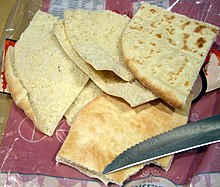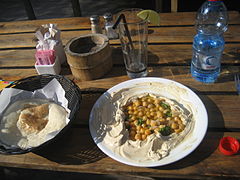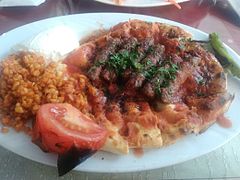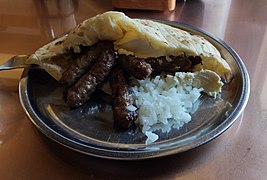 Pita from Greece | |
| Alternative names | Pide, Khubz |
|---|---|
| Type | Flatbread |
| Region or state | Eastern Mediterranean, Middle East[1] |
| Main ingredients | Wheat flour, water, yeast, salt |
Pita (Greek: πίτα, romanized: pita /ˈpɪtə/ or US: /ˈpiːtə/)[2] or pitta (British English) is a family of yeast-leavened round flatbreads baked from wheat flour, common in the Mediterranean, Levant, and neighboring areas. It includes the widely known version with an interior pocket, also known as Arabic bread (Arabic: خبز عربي; khubz ʿArabī). In the United Kingdom, Greek bread is used for pocket versions such as the Greek pita, and are used for barbecues as a souvlaki wrap.[3][4][1][5][6][7] The Western name pita may sometimes be used to refer to various other types of flatbreads that have different names in their local languages, such as numerous styles of Arab khubz (bread).[8]
Etymology
[edit]The first mention of the word in English cited in the Oxford English Dictionary was in 1936.[9] The English word is borrowed from Modern Greek πίτα (píta, "bread, cake, pie"), in turn from Byzantine Greek (attested in 1108),[9] possibly from Ancient Greek πίττα (pítta) or πίσσα (píssa), both "pitch/resin" for the gloss,[10][11] or from πικτή (piktḗ, "fermented pastry"), which may have passed to Latin as picta cf. pizza.[12][13][14] In Levantine Arabic it evolved into fatteh, (since Old Arabic /p/ evolved into /f/).[9] Other hypotheses trace the word back to the Classical Hebrew word פת (patt, lit. "a morsel of bread").[1] It is spelled like the Aramaic פיתא (pittā), from which it was received into Byzantine Greek (see above). Hypotheses also exist for Germanic[15] or Illyrian intermediaries.[16]
The word has been borrowed by the Turkish language as pide,[17] and appears in the Balkan languages as Bosnian-Serbian-Croatian pita, Romanian pită, Albanian pite, and Bulgarian pitka or pita; however, in the Serbo-Croatian languages of the countries comprising the former Yugoslavia, this culinary item is known as somun or lepinja while the word pita is used in a general sense meaning pie.
In Arabic, the phrase خبز البيتا (khabaz albayta, lit. "pita bread") is sometimes used; other names are simply خبز (khubz, "bread"), الخبز العربي (al-khubz al-ʿarabiyy, "Arab bread") or خبز الكماج (khabaz al-kimaj, "al-kimaj bread").[18] In Egypt, it is called عيش بلدي (ʽēš baladi) or simply عيش (ʽēš, "bread"),[19] although other subtypes of "bread" are common in Egypt, such as eish fino and eish merahrah.
In Greek, pita (πίτα) is understood by default to refer to the thicker, pocketless Greek pita, whereas the thinner khubz-style pita is referred to as aravikí pita (αραβική πίτα, lit. "Arabic pastry").
History
[edit]Pita has roots in the prehistoric flatbreads of the Near East.[1] There is evidence from about 14,500 years ago, during the Stone Age, that the Natufian people in what is now Jordan made a kind of flatbread from wild cereal grains.[20][21] Ancient wheat and barley were among the earliest domesticated crops in the Neolithic period of about 10,000 years ago, in the Fertile Crescent. By 4,000 years ago, bread was of central importance in societies such as the Babylonian culture of Mesopotamia, where the earliest-known written records and recipes of bread-making originate,[22] and where pita-like flatbreads cooked in a tinûru (tannur or tandoor) were a basic element of the diet, and much the same as today's tandoor bread, taboon bread,[23] and laffa, an Iraqi flatbread with many similarities with pita. However, there is no record of the steam-puffed, two-layer "pocket pita" in the ancient texts, or in any of the medieval Arab cookbooks, and according to food historians such as Charles Perry and Gil Marks it was likely a later development.[1][24]
Preparation
[edit]
Most pita breads are baked at high temperatures (450–475 °F (232–246 °C)), which turns the water in the dough into steam, thus causing the pita to puff up and form a pocket.[25] When removed from the oven, the layers of baked dough remain separated inside the deflated pita, which allows the bread to be opened to form a pocket. However, pita is sometimes baked without pockets and is called "pocket-less pita". Regardless of whether it is made at home or in a commercial bakery, pita is proofed for a very short time—only 15 minutes.[26]
Modern commercial pita bread is prepared on advanced automatic production lines, processing 100,000-pound (45,000 kg) silos of flour at a time and producing thousands of pitas per hour. The ovens used in commercial baking are much hotter than traditional clay ovens—800–900 °F (427–482 °C)—so each pita is baked only for one minute. The pita are then air-cooled for about 20 minutes on conveyor belts before being shipped immediately or else stored in commercial freezers kept at a temperature of 10 °F (−12 °C).[25]
Culinary use
[edit]Pita can be used to scoop sauces or dips, such as hummus, or to wrap kebabs, gyros, or falafel in the manner of sandwiches. It can also be cut and baked into crispy pita chips.
In Turkish cuisine, the word pide may refer to three different styles of bread: a flatbread similar to that eaten in Greece and Arab countries, a pizza-like dish, içli pide, where the filling is placed on the (often boat-shaped) dough before baking,[27][28][29][30] and Ramazan pidesi. The first type of pide is used to wrap various styles of kebab, while the second is topped with cheese, ground meat, or other fresh or cured meats, and/or vegetables. Regional variations in the shape, baking technique, and toppings create distinctive styles for each region.
In Cyprus, pita is typically rounder, fluffier and baked on a cast-iron skillet. It is used for souvlakia, sheftalia, halloumi with lountza, and gyros. In Greece the word pita means "pastry" and is usually used for various cakes and pastries like spanakopita (spinach pie) and karydopita (walnut cake) unrelated to the English language "pita" flatbread.[31] Traditional breads in Greek cuisine are leavened loaves,[32] such as the round καρβέλι karvéli or the oblong φραντζόλα frantzóla. This style of pita flatbread, in the English language meaning of the word, is almost exclusively used as a wrap for souvlaki or gyros usually garnished with some combination of tzatziki sauce, tomatoes, onions, and french fries.
In Israel, Druze pita is very popular. [33] The Druze-style pita is filled with labneh (thick yoghurt) and topped with olive oil and za’atar.[34]
In Bosnia, Croatia, Bulgaria and Serbia, the local style of pitta is known as lepinja, somun, purlenka or pitica, and is the most common bread served with barbecued food like ćevapi, pljeskavica, kebapche or grilled sausages. The word pita itself, on the other hand, is used for pie in the general sense in all local languages, and is mostly used for börek or various sweet phyllo pastry dishes (with the exception of baklava which is always called that).
Pita is also present in the cuisine of the Aromanians.[35]
-
Pide baking in wood fired oven in Istanbul
-
Karadeniz pidesi from Turkey topped with kaşar cheese
-
Ramadan pide
-
Gyro pide wrap
-
Baked khubz on conveyor in Tell Rifaat, Syria
-
Bosnian ćevapi served with local pitta variety called "somun"
See also
[edit]![]() Media related to Pita at Wikimedia Commons
Media related to Pita at Wikimedia Commons
![]() The dictionary definition of pita at Wiktionary
The dictionary definition of pita at Wiktionary
- Chapati – an unleavened flatbread from the Indian subcontinent
- Flour tortilla – a thin unleavened flatbread from Mexico
- Focaccia – a flat oven-baked bread from Italy
- Injera – a sourdough-risen flatbread from East Africa
- Khachapuri – a breaded cheese dish from Georgia
- Markook – an unleavened flatbread from the Middle East
- Matnakash – a leavened bread from Armenia (related to the Ramadan pita)
- Naan – a leavened, oven-baked flatbread from Central and South Asia
- Pită de Pecica – a round bread from Romania
- Rghaif – a pancake-like bread from Northwest Africa
References
[edit]- ^ a b c d e Marks, Gil (17 November 2010). Encyclopedia of Jewish Food. HMH. ISBN 9780544186316.
- ^ "Pita". Cambridge English Pronouncing Dictionary (18th ed.). Cambridge University Press. 2011.
- ^ Uvezian, Sonia (2001). Recipes and Remembrances from an Eastern Mediterranean Kitchen: A Culinary Journey Through Syria, Lebanon, and Jordan. Siamanto Press. p. 313. ISBN 9780970971685 – via Google Books.
The best-known bread of the region is khubz arabi (or, simply, khubz), a round, flat, slightly leavened loaf about one-fourth inch thick and with a pocket inside. It is made in three different sizes: large (eight or more inches in diameter), medium (six to eight inches), and small (about five inches). In America, where it has become very popular, this bread is known as pita. A pocketless version is also available. In some Arab communities khubz arabi is called kmaj (from the Persian kumaj), while in others, kmaj refers only to the pocketless type.
- ^ Stewart, Jean E.; Tamaki, Junko Alice (1992). Composition of foods: baked products : raw, processed, prepared. Vol. 8. United States Department of Agriculture, Nutrition Monitoring Division. p. 6. ISBN 9780160380440.
Pita bread originated in the Middle East and is also known as Arabic, Syrian, and pocket bread.
- ^ Perry, Charles (21 August 2014). Davidson, Alan (ed.). The Oxford Companion to Food. Oxford University Press. pp. 629–630. ISBN 9780191040726 – via Google Books.
- ^ Wright, Clifford A. (2003). Little Foods of the Mediterranean: 500 Fabulous Recipes for Antipasti, Tapas, Hors D'Oeuvre, Meze, and More. Harvard Common Press. p. 61. ISBN 9781558322271.
- ^ Roden, Claudia (24 December 2008). The New Book of Middle Eastern Food. Knopf Doubleday Publishing Group. pp. 393–396. ISBN 9780307558565 – via Google Books.
- ^ Serna-Saldivar, Sergio O. (2012). Cereal Grains: Laboratory Reference and Procedures Manual. CRC Press. p. 215. ISBN 9781439855652.
- ^ a b c "pitta". Oxford English Dictionary (Online ed.). Oxford University Press. (Subscription or participating institution membership required.)
- ^ Aristotle University of Thessaloniki, Λεξικό της κοινής Νεοελληνικής
- ^ Liddell, Henry George; Scott, Robert; Jones, Henry Stuart. A Greek–English Lexicon.
- ^ Javna, John. Uncle John's FACTASTIC Bathroom Reader, Printers Row, 2015
- ^ Babiniotis, Georgios (2005). Λεξικό της Νέας Ελληνικής Γλώσσας [Dictionary of Modern Greek] (in Greek). Lexicology Centre. p. 1413. ISBN 960-86190-1-7.
- ^ The connection between picta and πηκτή is not supported by the OED s.v. 'picture' nor by Buck, Carl Darling, A Dictionary of Selected Synonyms in the Principal Indo-European Languages (1949). 9.85 "paint", p. 629
- ^ Bracvini, G. Princi (1979). Archivio Glottologico Italiano. Vol. 64. pp. 42–89. Cited by the OED.
- ^ Kramer, J. (1990). Balkan-Archiv. Vol. 14–15. pp. 220–231. Cited by the OED.
- ^ Civitello, Linda (2007). Cuisine and culture: a history of food and people (Paperback ed.). Wiley. p. 98. ISBN 978-0471741725.
- ^ Cauvain, Stanley (2015). Technology of Breadmaking. New York: Springer. p. 232. ISBN 978-3-319-14687-4.
- ^ Bard, Kathryn A. (2005). Encyclopedia of the Archaeology of Ancient Egypt. London: Routledge. p. 178. ISBN 978-1-134-66525-9.
- ^ "World's oldest bread found at prehistoric site in Jordan", The Jerusalem Post, 2018, retrieved 16 July 2018
- ^ "Archaeologists find world's oldest bread and new evidence of sophisticated cooking dating back 14,000 years". The Independent. Retrieved 17 July 2018.
- ^ "Mastering the Art of Babylonian Cooking". The New York Times. Associated Press. 3 January 1988. ISSN 0362-4331. Retrieved 16 March 2019.
- ^ Bottéro, Jean (15 April 2004). The Oldest Cuisine in the World: Cooking in Mesopotamia. University of Chicago Press. pp. 47–49. ISBN 9780226067353 – via Google Books.
- ^ Helman, Anat (28 October 2015). Jews and Their Foodways. Oxford University Press. ISBN 9780190265434 – via Google Books.
- ^ a b McNulty, Mary (2007). "Pita Bread". How products are made. Retrieved 8 May 2018.
- ^ Tanis, David (21 February 2014). "Homemade Pita Bread". The New York Times. Retrieved 8 May 2018.
- ^ Colon-Singh, Rose (12 June 2012). "Make Flatbread | Turkish Pide Recipe". Fine Dining Lovers. Retrieved 10 December 2018.
- ^ "Dayi'nin Yeri Turkish Restaurant, Cliffside Park, NJ". www.chowgofer.com. Retrieved 10 December 2018.
- ^ Elise, Lola (16 December 2009). "Pide Recipe". Tasty & Healthy Arbuz. Retrieved 10 December 2018.
- ^ Babs, Serena (17 January 2011). "Turkish Pizza aka Kiymali Pide". Tasty Kitchen. Retrieved 10 December 2018.
- ^ Ιφιγενεια Βιρβιδακη, Νενα Δημητριου, Νικολετα Μακρυωνιτου, Καλλιοπη Πατερα, "Tα καλύτερα ψωμιά των Αθηνών", Γαστρονόμος, Η Καθημερινή, 21 September 2016
- ^ Ιφιγενεια Βιρβιδακη, Νενα Δημητριου, Νικολετα Μακρυωνιτου, Καλλιοπη Πατερα, "Tα καλύτερα ψωμιά των Αθηνών", Γαστρονόμος, Η Καθημερινή, 21 September 2016 [1]
- ^ "A Taste of Druze Cuisine". Tabletmag. 20 November 2019.
- ^ Isalska, Anita (2018). Lonely Planet Israel & the Palestinian Territories. Lonely Planet. p. 5. ISBN 9781787019249.
- ^ Bara, Mariana (2014). "Constructing Armân/Vlach Ethnic Identity" (PDF). HyperCultura. 3 (1): 1–11.











